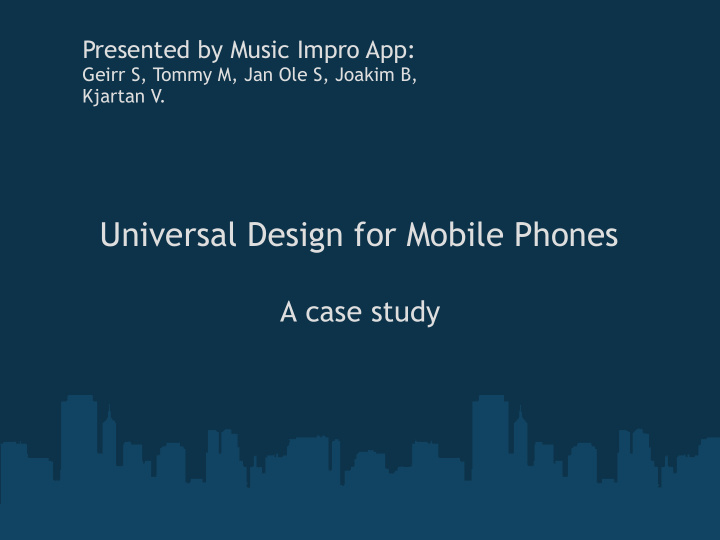



Presented by Music Impro App: Geirr S, Tommy M, Jan Ole S, Joakim B, Kjartan V. Universal Design for Mobile Phones A case study
Authors & context • Authors: Pios Ornella & Buisine Stéphanie representing Ecole Nationale Supérieure d'arts et Métiers • Describing a case study from 2006 in Montréal, Québec, Canada • Relevance: 20% of the world population and approx. 50% in most industrial countries are equipped with mobile phones Motivation: • Challenges for mobile technology vs people with disabillities • Inclusive design vs exclusive design • Universal design as means
Universal design Usabillity dimensions: • Include usability aspects so that usabillity issues cover most people dispite being experts, novice, old or disabeled • Not designing for a special group (which is normal), but to "produce interfaces that are better for all users" (Shneiderman in Sharp, Rogers & Preece 2007) Image and values: • Designing artefacts that can be used for the disabeled also need consider normal trends regarding look and feel. • Otherwise it can appear exclusive and not inclusive.
Challenge: "If the product displays the idea of disability, it is likely to be rejected by the users it is intended for" ( Pios & Buisine 2006) Having a disability does not necessarily mean you want your phone to look like this
Design process Target users: • Visually impaired/blind • Hearing impaired/deaf • Elderly Process: • Based on data from a big survey of how these users use their mobiles • Research, interviews, observations and prototyping
Factors and considerations Visual impairment: Being born blind is easier than becomming blind Considerations: Touch interface and audio comminication Hearing impairment: Interference with auditory prosthesis, amplifiers, videophones not sufficiently widespread Considerations: The keypad, T9, Visual and vibrating alerts Elderly people: Mostly only using the mobile as a regular phone Considerations: easy to use keypad, high enough volume and visibillity
User testing and prototyping 1.Researching existing products 2.Semantic map x = high to low innovation y = high to low simplicity 3.Defining users values 4.Producing mock-ups Authors opinion of the result: "mock-ups do not look like existing products for disabeled people" What do you think? (keep in mind that this was done in 2006)
CLUE! "System designers who invent strategies to accomodate young and old, novice and expert, and users with various disabilities will earn the appreciation of users and the respect of their colleagues." (Shneiderman in: Sharp, Rogers & Preece 2007)
Recommend
More recommend